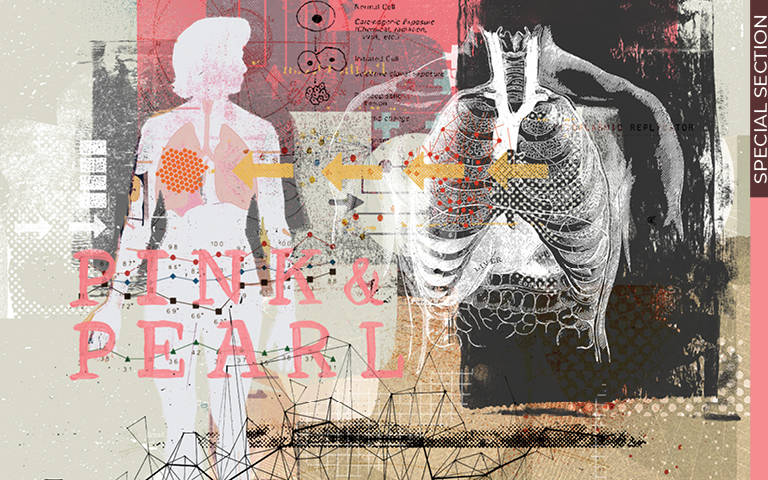Some things just go together: peanut butter and jelly, salt and pepper, and now — breast and lung cancer awareness. The Tennessee Pink and Pearl Campaign (pink representing breast cancer and pearl representing lung cancer, which is often signified by a white ribbon) aims to bring awareness to both health issues by combining efforts to encourage patients to get their recommended cancer screenings. “Breast cancer awareness is so successful — in October, you can’t watch football or go to the mall without seeing pink. We’re hoping to use that success to advocate for lung cancer screening (LCS), which is not as visible and tends to have a stigma attached to it,” says Kim L. Sandler,MD, co-director of the Vanderbilt Lung Screening Program and associate professor of radiology at Vanderbilt University.
“Lung cancer is really a women’s health crisis,” says Sandler. “It kills more women than breast and ovarian cancer combined, but we don’t talk about it as really being a women’s issue.1 We can decrease deaths with screening and early detection. But that’s only half of the equation: you also need patients coming in for regular screenings.”
The idea for the Pink and Pearl Campaign began when members of the Tennessee Department of Health attended the Vanderbilt University Medical Center’s Rural Health Consortium, where Sandler presented a study she authored, “Women Screened for Breast Cancer are Dying From Lung Cancer: An Opportunity to Improve LCS in A Mammography Population.” In the study, researchers identified 251 women undergoing screening mammography at the medical center who were also eligible for LCS in 2016. By 2019, 63 of those women had enrolled in lung screening. Three were diagnosed with lung cancer via screening, and zero deaths had occurred. Of the remaining 188 who were not screened, seven were diagnosed with lung cancer, resulting in five deaths. The study concluded that women who followed health recommendations and were screened for breast cancer were still dying from lung cancer, which is also detected easily by screening.2
“We saw an opportunity,” explains Rochelle Roberts, MOL, chronic disease program director with the Tennessee Department of Health. “Because October is Breast Cancer Awareness Month and November is Lung Cancer Awareness Month, we could combine he two into one campaign, capitalizing on the notoriety of breast cancer awareness to bring more awareness to lung cancer.”
GETTING THE WORD OUT
The Pink and Pearl Campaign is currently in its third year and has developed a wide variety of resources and outreach programs, including a toolkit that provides sample social media posts for the campaign, as well as strategies for awareness and educational resources.
Because October is Breast Cancer Awareness Month and November is Lung Cancer Awareness Month, we could combine the two into one campaign, capitalizing on the notoriety of breast cancer awareness to bring more awareness to lung cancer.
They’ve also developed promotional cards that explain the U.S. Preventive Services Taskforce (USPSTF) screening guidelines and screening reminder cards for practices to use. These cards are also available in Spanish, Arabic, and Vietnamese to connect with multiple populations in Tennessee.
The Pink and Pearl Campaign also includes an educational event called “Pearls of Knowledge.” Created in partnership with the Tennessee Cancer Coalition, this annual event invites panelists such as smoking cessation hotline personnel, oncologists, radiologists, and others to answer questions about lung and breast cancer.
Their outreach has paid off. The governor of Tennessee designated Nov. 5, 2021, as “Pink and Pearl Lung and Breast Cancer Screening Awareness Day,” and the state capitol building was lit pink throughout the week. “We’re really pushing for Pink and Pearl Lung and Breast Cancer Screening Awareness Day to be an annual event. We’d like the first Friday of every November to be Pink and Pearl Day,” says Roberts.
Much of the success of the campaign is due to working closely with other organizations, Roberts notes. The Pink and Pearl Campaign works with organizations across the spectrum, such as the Tennessee Comprehensive Cancer Program, the Tennessee Breast and Cervical Screening Program, the Tennessee Cancer Registry, and departments across the Tennessee Department of Health, such as Health Promotion and the Division of Minority Health and Disparities Elimination. “No single organization sector or department can change the course of health of Tennesseans without collaboration,” adds Roberts.
JOINING THE CAUSE
“In the same vein, no screening campaign would be complete without the participation of radiologists,” says Sandler. “We’re at the center of screening. It makes sense for radiologists to take ownership of LCS and to be having important conversations with providers, organizations, and patients to improve rates and save more lives.” Roberts encourages radiologists who would like to be involved in or create similar campaigns to join their state’s cancer coalition, which exists to help address the cancer burden in each state.
Both Roberts and Sandler say that radiologists can help lung cancer outreach by talking about it with their patients. “If physicians have these conversations with their patients, the patients could bring it up with their family and friends. We could normalize and reduce the stigma,” says Roberts.
Adds Sandler, “There are millions of Americans who qualify for lung screening; we have a lot of work to do to provide education, eliminate the stigma, and increase screening. My hope is that radiologists will be at the center of that conversation.”

